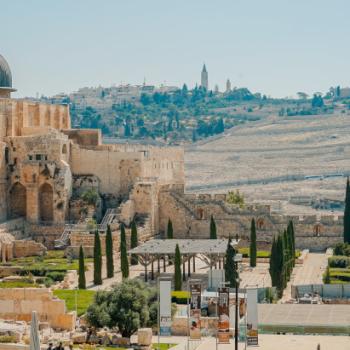
In the second chapter of his gospel, John records Jesus’ first “sign” at the beginning of his ministry. Most Christians are familiar with the story: Jesus was at a wedding in the town of Cana, the wine ran out, and Jesus turned water into wine to keep the celebration going. The master of the feast, not realizing what Jesus had done, went to the groom in confusion, wondering why he had kept the best wine for the end of the feast.
As with many of Jesus’ miracles, it can be tempting to see this event as simply a supernatural thing that Jesus did to reveal his power, his divinity, and his identity as the Son of God. And that’s not wrong. John 2:11 says that Jesus “manifested his glory” by carrying out the sign at the wedding.
But, while Jesus’ miracles do clearly reveal his power and identity, the gospel authors often frame the events in his life in ways that encourage us to see deeper literary symbolism in what’s going on. I’ve written in the past, for example, about how the language and imagery in Mark’s account of the feeding of the 5000 paints Jesus as the good shepherd.
And I think Jesus’ miracle at the wedding at Cana is no different. It reveals his power, yes. But I believe it’s the first of a series of incidents in John’s gospel (and, indeed, in John’s broader writings) that deal with the theme of Jesus as the ultimate bridegroom. Let me see if I can show you what I mean.
The Punchline of the Wedding at Cana
I think the best way to see what’s going on in this miracle is to go back to the text at John 2 and to look for the punchline of the story. What’s the dramatic takeaway? What interpretation does John give for us in the story?
If we start thinking about this question, it’s interesting to note that John does not record anybody’s reaction to the miracle itself. In John 2:7-8, Jesus instructs some servants to fill some stone jars with water, then draw some and take it to the master of the feast. Logically, at least one of those servants must have seen the water turn into wine right before their very eyes.
But we don’t have any record of the servant’s reaction to this supernatural event. Nor do we have any explanation given to the master of the feast as to where the wine came from. He’s clearly confused about what’s going on, which would be a great opportunity for somebody to declare “hey, this Jesus guy turned water into wine!” to the shock and awe of the crowd. But John doesn’t record anything like that at all!
Jesus and the Groom
But instead of a punchline that emphasizes the supernatural event that just took place, what do we get? We get the reaction of the master of the feast in John 2:9-10.
When the master of the feast tasted the water now become wine, and did not know where it came from (though the servants who had drawn the water knew), the master of the feast called the bridegroom and said to him, “Everyone serves the good wine first, and when people have drunk freely, then the poor wine. But you have kept the good wine until now.”
And there are two crucial components we need to see about this. First, the master of the feast clearly believes that it’s the groom’s responsibility to provide the wine—that’s why he calls the groom to answer questions about it. And second, the master of the feast refers to the wine Jesus has created as the “good wine,” better than whatever had been served previously.
Jesus, then, has symbolically taken on the role of the bridegroom—he’s provided wine for the wedding celebration, which is what the groom was supposed to do. And not only that, Jesus has clearly outdone the groom! Whereas the groom’s wine was inferior and insufficient, Jesus’ wine was both better-tasting and more abundant! In fact, the translators of the ESV suggest Jesus likely made 120 to 180 gallons of it!
Symbolically, then, this story reveals Jesus to be a superior bridegroom. The “glory” that he manifests is not just that of a miracle-worker, but also that of the spiritual husband that God had promised would come to restore his relationship with his estranged bride, Israel (see, e.g., Hosea 2).
Context Clues
Of course, some might say that the case I’ve provided so far is fairly flimsy evidence that “Jesus is the groom” is the intended takeaway from this passage. But I think there’s good reason to believe that John’s working with the idea of Jesus as the groom throughout the first several chapters of his gospel.
The most definitive example of this is in John 3, just one chapter after the wedding at Cana incident. There, John the Baptist is speaking about Jesus, and he has this to say (John 3:28-30).
You yourselves bear me witness, that I said, ‘I am not the Christ, but I have been sent before him.’ The one who has the bride is the bridegroom. The friend of the bridegroom, who stands and hears him, rejoices greatly at the bridegroom’s voice. Therefore this joy of mine is now complete. He must increase, but I must decrease.
Here, only one chapter after the wedding at Cana, John the Baptist is declaring Jesus to be “the bridegroom.” This context suggests that the Jesus-as-groom idea was at least near the top of John’s mind when he was composing the first few chapters of his gospel.
But it continues! As I’ve argued in the past, it’s very likely that Jesus’ conversation with the Samaritan woman in John 4 also deals with the theme of Jesus as the ultimate groom.
Taken together, it seems that these three incidents, in three consecutive chapters of John, reveal John’s literary intent to portray Jesus as the ultimate spiritual husband, come to call the church to be his bride (see, e.g., Ephesians 5).
The Bigger Picture
And this isn’t just an idea that John came up with. Rather, the idea of God and his people as husband and wife is one of the most unifying themes in scripture. It appears at least as early as Exodus 34:15-16 and stretches all the way to Revelation.
In the prophets, for example, Israel is pictured as a little orphan girl rescued by God and called to be his wife (Ezekiel 16). But, despite God’s kindness to Israel, she “played the whore” with other gods, committing spiritual adultery through her unfaithfulness to him (e.g., Ezekiel 16, 23). Nevertheless, God promises that he will one day “woo” his people again and “betroth her to him forever in faithfulness” (Hosea 2). He promises to one day come and win his bride back!
But, of course, God makes other promises as well. In Isaiah 25, for example, he promises that he will one day throw a lavish feast for his people, with wine and good food. Isaiah goes on to say that on the day when God does this, death will be no more and every tear will be wiped away. It’s the promise of a beautiful restoration of all that’s gone wrong in the world, with a feast to celebrate appropriately!
And, more than any other biblical author, it’s John who brings all of these ideas together! Indeed, in Revelation 19 and 21, we see the church presented to Jesus “as a bride adorned for her husband.” Every tear is wiped away, death is no more. God throws a lavish feast, the “wedding supper of the lamb,” and he calls all those who are invited to attend “blessed.”
Jesus, the true bridegroom, having outdone the earthly groom at Cana, finally throws a celebration worthy of his own marriage to the people he’s redeemed for himself. This is John 2, and so much else, in final consummation.
Got Thoughts?
I’m not the first to propose this interpretation of the wedding at Cana. In fact, while I’m not Catholic, some quick research while writing this post suggested that the interpretation of John 2 I’ve suggested today is quite common in the Catholic tradition.
But I’d love to know if this interpretation is persuasive to you! Would you leave a comment below and let me know what you’re thinking?
I should also say that, if the topic of God and his people as bride and groom is something your interested in, it’s something I’m exploring regularly. For example, I’ve discussed how that theme appears in other passages, I’ve argued that it should be the basis for our sexual ethics, and I’ve applied it specifically to the question of premarital sex. Feel free to come back to read more, or follow me on Twitter if you’d like more thoughts on this topic!












